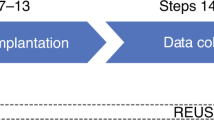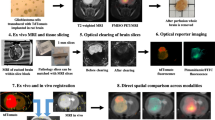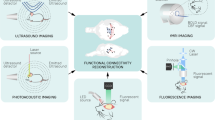Abstract
The study of neural repair and neuroplasticity in rodents would be enhanced by the ability to assess neuronal function in vivo. Positron emission tomography (PET) is used to study brain plasticity in humans, but the limited resolution and sensitivity of conventional scanners have generally precluded the use of PET to study neuroplasticity in rodents. We now demonstrate that microPET, a PET scanner developed for use with small animals, can be used to assess metabolic activity in different regions of the conscious rodent brain using [18F]fluorodeoxyglucose (FDG) as the tracer, and to monitor changes in neuronal activity. Limbic seizures result in dramatically elevated metabolic activity in the hippocampus, whereas vibrissal stimulation results in more modest increases in FDG uptake in the contralateral neocortex. We also show that microPET can be used to study lesion-induced plasticity of the brain. Cerebral hemidecortication resulted in diminished relative glucose metabolism in the neostriatum and thalamus ipsilateral to the lesion, with subsequent, significant recovery of metabolic function. These studies demonstrate that microPET can be used for serial assessment of metabolic function of individual, awake rats with a minimal degree of invasiveness, and therefore, has the potential for use in the study of brain disorders and repair.
This is a preview of subscription content, access via your institution
Access options
Subscribe to this journal
Receive 12 print issues and online access
$209.00 per year
only $17.42 per issue
Buy this article
- Purchase on Springer Link
- Instant access to full article PDF
Prices may be subject to local taxes which are calculated during checkout





Similar content being viewed by others
References
Kennedy, C. et al. Mapping of functional neural pathways by autoradiographic survey of local metabolic rate with [14C]deoxyglucose. Science 187, 850–853 (1975).
Schwartz, W.J. et al. Metabolic mapping of functional activity in the hypothalamo-neurohypophysial system of the rat. Science 205, 723–725 (1979).
Greer, C.A., Stewart, W.B., Kauer, J.S. & Shepherd, G.M. Topographical and laminar localization of 2-deoxyglucose uptake in rat olfactory bulb induced by electrical stimulation of olfactory nerves. Brain Res. 217, 279–293 (1981).
Chugani, H.T., Hovda, D.A., Villablanca, J.R., Phelps, M.E. & Xu, W.F. Metabolic maturation of the brain: a study of local cerebral glucose utilization in the developing cat. J Cereb. Blood Flow Metab. 11, 35–47 (1991).
Bruehl, C. & Witte, O.W. Cellular activity underlying altered brain metabolism during focal epileptic activity. Ann. Neurol. 38, 414–420 (1995).
Hovda, D.A., Villablanca, J.R., Chugani, H.T. & Phelps, M.E. Cerebral metabolism following neonatal or adult hemineodecortication in cats: I. Effects on glucose metabolism using [14C]2-deoxy-D-glucose autoradiography. J. Cereb. Blood Flow Metab. 16, 134–146 (1996).
Collins, R.C., McLean, M. & Olney, J. Cerebral metabolic response to systemic kainic acid: 14C-deoxyglucose studies. Life Sci. 27, 855–862 (1980).
Ben-Ari, Y., Tremblay, E., Riche, D., Ghilini, G. & Naquet, R. Electrographic, clinical and pathological alterations following systemic administration of kainic acid, bicuculline or pentetrazole: metabolic mapping using the deoxyglucose method with special reference to the pathology of epilepsy. Neuroscience 6, 1361–1391 (1981).
Albala, B.J., Moshe, S.L. & Okada, R. Kainic-acid-induced seizures: a developmental study. Brain Res. 315, 139–148 (1984).
Chugani, H.T. & Jacobs, B. Metabolic recovery in caudate nucleus of children following cerebral hemispherectomy. Ann. Neurol. 36, 794–797 (1994).
Iglesias, S. et al. Do changes in oxygen metabolism in the unaffected cerebral hemisphere underlie early neurological recovery after stroke? A positron emission tomography study. Stroke 27, 1192–1199 (1996).
Bergsneider, M. et al. Cerebral hyperglycolysis following severe traumatic brain injury in humans: a positron emission tomography study [see comments]. J Neurosurg 86, 241–251 (1997).
Muller, R.A., Chugani, H.T., Muzik, O. & Mangner, T.J. Brain organization of motor and language functions following hemispherectomy: a [15O]-water positron emission tomography study. J. Child Neurol. 13, 16–22 (1998).
Kuhl, D.E., Engel, J. Jr., Phelps, M.E. & Selin, C. Epileptic patterns of local cerebral metabolism and perfusion in humans determined by emission computed tomography of 18FDG and 13NH3 . Ann. Neurol. 8, 348–360 (1980).
Chugani, H.T., Rintahaka, P.J. & Shewmon, D.A. Ictal patterns of cerebral glucose utilization in children with epilepsy. Epilepsia 35, 813–822 (1994).
Melega, W.P. et al. Recovery of striatal dopamine function after acute amphetamine- and methamphetamine-induced neurotoxicity in the vervet monkey. Brain Res. 766, 113–120 (1997).
Brownell, A.L. et al. PET and MR studies of experimental focal stroke. J. Comput. Assist. Tomogr. 15, 376–380 (1991).
Magata, Y. et al. Noninvasive measurement of cerebral blood flow and glucose metabolic rate in the rat with high-resolution animal positron emission tomography (PET): a novel in vivo approach for assessing drug action in the brains of small animals. Biol. Pharm. Bull. 18, 753–756 (1995).
Ouchi, Y. et al. Cholinergic projection from the basal forebrain and cerebral glucose metabolism in rats: a dynamic PET study [see comments]. J. Cereb. Blood Flow Metab. 16, 34–41 (1996).
Kuge, Y. et al. Positron emission tomography for quantitative determination of glucose metabolism in normal and ischemic brains in rats: an insoluble problem by the Harderian glands. J. Cereb. Blood Flow Metab. 17, 116–120 (1997).
Cherry, S. et al. MicroPET: a high resolution PET scanner for imaging small animals. IEEE Trans. Nucl. Sci. 44, 1161–1166 (1997).
Chatziioannou, A.F. et al. Performance evaluation of microPET: a high-resolution LSO PET scanner for animal imaging. J. Nucl. Med. 40, 1164–1175 (1999).
Chugani, H.T. et al. Surgical treatment of intractable neonatal-onset seizures: the role of positron emission tomography. Neurology 38, 1178–1188 (1988).
Chugani, H.T. & Phelps, M.E. Maturational changes in cerebral function in infants determined by 18FDG positron emission tomography. Science 231, 840–843 (1986).
Cutler, P.D., Cherry, S.R., Hoffman, E.J., Digby, W.M. & Phelps, M.E. Design features and performance of a PET system for animal research. J. Nucl. Med. 33, 595–604 (1992).
Kinahan, P. & Rogers, J. Analytic 3D imager reconstruction using all detected events. IEEE Trans. Nucl. Sci. 36, 964–968 (1989).
Qi, J., Leahy, R.M., Cherry, S.R., Chatziioannou, A. & Farquhar, T.H. High-resolution 3D Bayesian image reconstruction using the microPET small-animal scanner. Phys. Med. Biol. 43, 1001–1013 (1998).
Dietrich, W.D., Ginsberg, M.D., Busto, R. & Smith, D.W. Metabolic alterations in rat somatosensory cortex following unilateral vibrissal removal. J. Neurosci. 5, 874–880 (1985).
Kossut, M. Effects of sensory denervation and deprivation on a single cortical vibrissal column studied with 2-deoxyglucose. Physiol. Bohemoslov. 34, 79–83 (1985).
Miller, M.W. & Dow-Edwards, D.L. Vibrissal stimulation affects glucose utilization in the trigeminal/somatosensory system of normal rats and rats prenatally exposed to ethanol. J. Comp. Neurol. 335, 283–284 (1993).
Dunn-Meynell, A.A. & Levin, B.E. Lateralized effect of unilateral somatosensory cortex contusion on behavior and cortical reorganization. Brain Res. 675, 143–156 (1995).
Krynaw, R. Infantile hemiplegia treated by removing one cerebral hemisphere. J. Neurol. Neurosurg. Psychiatry 13, 243–267 (1950).
Napieralski, J.A., Butler, A.K. & Chesselet, M.F. Anatomical and functional evidence for lesion-specific sprouting of corticostriatal input in the adult rat. J. Comp. Neurol. 373, 484–497 (1996).
Chatziioannou, A. et al. Comparison of 3D maximum a posteriori and filtered backprojection algorithms for high resolution animal imaging with microPET. IEEE Trans. Med. Imag. in press (2000).
Moore, A., Cherry, S., Annala, A. & Hovda, D. Quantitative assessment of FDG-PET studies in rat brain using microPET. J. Cereb. Blood Flow Metab. 19(Suppl 1), S764 (1999).
Hoffman, E.J., Huang, S.C. & Phelps, M.E. Quantitation in positron emission computed tomography: 1. Effect of object size. J. Comput. Assist. Tomogr. 3, 299–308 (1979).
Coyle, J.T. Neurotoxic action of kainic acid. J. Neurochem. 41, 1–11 (1983).
Sokoloff, L. et al. The [14C]deoxyglucose method for the measurement of local cerebral glucose utilization: theory, procedure, and normal values in the conscious and anesthetized albino rat. J. Neurochem. 28, 897–916 (1977).
Kolb, B., Gibb, R. & van der Kooy, D. Cortical and striatal structure and connectivity are altered by neonatal hemidecortication in rats. J. Comp. Neurol. 322, 311–324 (1992).
Tatsukawa, K., Shields, S. & Kornblum, H. Limited corticostriatal plasticity following hemidecortication in the rat. Soc. Neurosci. Abstr. 23, 1447 (1997).
Kolb, B. Recovery from early cortical damage in rats. I. Differential behavioral and anatomical effects of frontal lesions at different ages of neural maturation. Behav. Brain Res. 25, 205–220 (1987).
Fowler, J. & Wolf, A. Positron emitter-labeled compounds. in Positron emission tomography and autoradiography. (eds Phelps, M.E., Mazziotta, J. & Schelbert, H.R.) 391–450 (Raven Press, New York; 1986).
Phelps, M.E. et al. Tomographic measurement of local cerebral glucose metabolic rate in humans with (F-18)2-fluoro-2-deoxy-D-glucose: validation of method. Ann. Neurol. 6, 371–388 (1979).
Ackermann, R.F. & Lear, J.L. Glycolysis-induced discordance between glucose metabolic rates measured with radiolabeled fluorodeoxyglucose and glucose. J. Cereb. Blood Flow Metab. 9, 774–785 (1989).
Kornblum, H.I., Chugani, H.T., Tatsukawa, K. & Gall, C.M. Cerebral hemidecortication alters expression of transforming growth factor alpha mRNA in the neostriatum of developing rats. Brain Res. Mol. Brain Res. 21, 107–114 (1994).
Acknowledgements
The authors thank Drs. Kim Seroogy and Roger Woods for helpful review of the manuscript, Dr. Arion Chatziioannou for technical assistance with microPET and helpful discussions regarding quantitation, Dr. Amy Moore for aid in the performance of kinetic studies, and Drs. Richard Leahy and Jinyi Qi for providing the MAP reconstruction algorithm. We also thank Ron Sumida, Judy Edwards, Der-Jenn Liu, Victor Dominguez, and Waldimar Ladno for outstanding assistance with microPET scanning, and Ms. Cheri Sneed for some initial data analysis. This work was supported by the Department of Energy, contract DE-FC03-ER60615 (S.R.C., M.E.P., D.M.J., H.I.K.), NIH grants CA69370-03 (S.R.C.), and NS01837-01A1 (H.I.K.).
Author information
Authors and Affiliations
Corresponding author
Rights and permissions
About this article
Cite this article
Kornblum, H., Araujo, D., Annala, A. et al. In vivo imaging of neuronal activation and plasticity in the rat brain by high resolution positron emission tomography (microPET). Nat Biotechnol 18, 655–660 (2000). https://doi.org/10.1038/76509
Received:
Accepted:
Issue Date:
DOI: https://doi.org/10.1038/76509
This article is cited by
-
B-Glycine as a marker for β cell imaging and β cell mass evaluation
European Journal of Nuclear Medicine and Molecular Imaging (2024)
-
PET imaging of metabolic changes after neural stem cells and GABA progenitor cells transplantation in a rat model of temporal lobe epilepsy
European Journal of Nuclear Medicine and Molecular Imaging (2019)
-
Mapping Changes of Whole Brain Blood Flow in Rats with Myocardial Ischemia/Reperfusion Injury Assessed by Positron Emission Tomography
Current Medical Science (2019)
-
Inter-subject FDG PET Brain Networks Exhibit Multi-scale Community Structure with Different Normalization Techniques
Annals of Biomedical Engineering (2018)
-
Stable long-term chronic brain mapping at the single-neuron level
Nature Methods (2016)



